Lu Feng
Jeffrey
Counterfactual Explanations for Continuous Action Reinforcement Learning
May 19, 2025Abstract:Reinforcement Learning (RL) has shown great promise in domains like healthcare and robotics but often struggles with adoption due to its lack of interpretability. Counterfactual explanations, which address "what if" scenarios, provide a promising avenue for understanding RL decisions but remain underexplored for continuous action spaces. We propose a novel approach for generating counterfactual explanations in continuous action RL by computing alternative action sequences that improve outcomes while minimizing deviations from the original sequence. Our approach leverages a distance metric for continuous actions and accounts for constraints such as adhering to predefined policies in specific states. Evaluations in two RL domains, Diabetes Control and Lunar Lander, demonstrate the effectiveness, efficiency, and generalization of our approach, enabling more interpretable and trustworthy RL applications.
IrrMap: A Large-Scale Comprehensive Dataset for Irrigation Method Mapping
May 13, 2025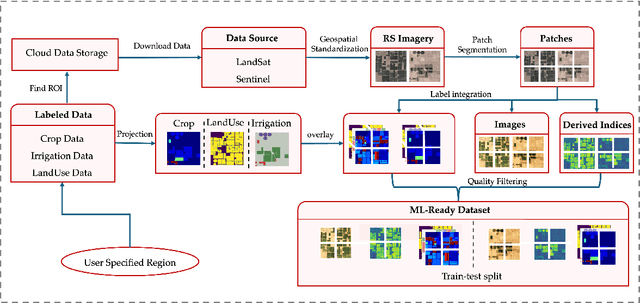


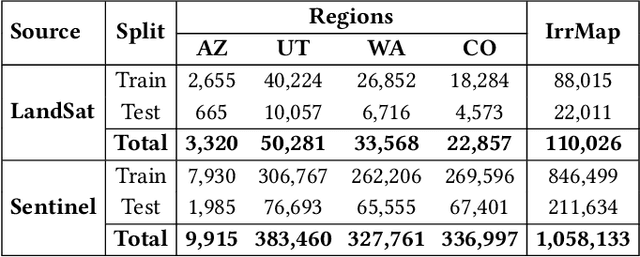
Abstract:We introduce IrrMap, the first large-scale dataset (1.1 million patches) for irrigation method mapping across regions. IrrMap consists of multi-resolution satellite imagery from LandSat and Sentinel, along with key auxiliary data such as crop type, land use, and vegetation indices. The dataset spans 1,687,899 farms and 14,117,330 acres across multiple western U.S. states from 2013 to 2023, providing a rich and diverse foundation for irrigation analysis and ensuring geospatial alignment and quality control. The dataset is ML-ready, with standardized 224x224 GeoTIFF patches, the multiple input modalities, carefully chosen train-test-split data, and accompanying dataloaders for seamless deep learning model training andbenchmarking in irrigation mapping. The dataset is also accompanied by a complete pipeline for dataset generation, enabling researchers to extend IrrMap to new regions for irrigation data collection or adapt it with minimal effort for other similar applications in agricultural and geospatial analysis. We also analyze the irrigation method distribution across crop groups, spatial irrigation patterns (using Shannon diversity indices), and irrigated area variations for both LandSat and Sentinel, providing insights into regional and resolution-based differences. To promote further exploration, we openly release IrrMap, along with the derived datasets, benchmark models, and pipeline code, through a GitHub repository: https://github.com/Nibir088/IrrMap and Data repository: https://huggingface.co/Nibir/IrrMap, providing comprehensive documentation and implementation details.
Evaluating Human Trust in LLM-Based Planners: A Preliminary Study
Feb 27, 2025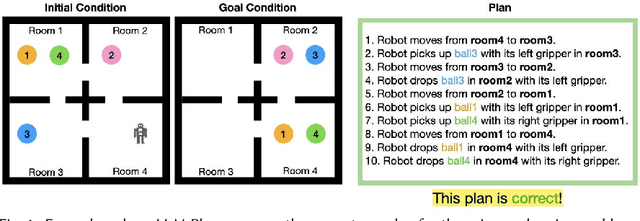



Abstract:Large Language Models (LLMs) are increasingly used for planning tasks, offering unique capabilities not found in classical planners such as generating explanations and iterative refinement. However, trust--a critical factor in the adoption of planning systems--remains underexplored in the context of LLM-based planning tasks. This study bridges this gap by comparing human trust in LLM-based planners with classical planners through a user study in a Planning Domain Definition Language (PDDL) domain. Combining subjective measures, such as trust questionnaires, with objective metrics like evaluation accuracy, our findings reveal that correctness is the primary driver of trust and performance. Explanations provided by the LLM improved evaluation accuracy but had limited impact on trust, while plan refinement showed potential for increasing trust without significantly enhancing evaluation accuracy.
Quantitative Predictive Monitoring and Control for Safe Human-Machine Interaction
Dec 17, 2024



Abstract:There is a growing trend toward AI systems interacting with humans to revolutionize a range of application domains such as healthcare and transportation. However, unsafe human-machine interaction can lead to catastrophic failures. We propose a novel approach that predicts future states by accounting for the uncertainty of human interaction, monitors whether predictions satisfy or violate safety requirements, and adapts control actions based on the predictive monitoring results. Specifically, we develop a new quantitative predictive monitor based on Signal Temporal Logic with Uncertainty (STL-U) to compute a robustness degree interval, which indicates the extent to which a sequence of uncertain predictions satisfies or violates an STL-U requirement. We also develop a new loss function to guide the uncertainty calibration of Bayesian deep learning and a new adaptive control method, both of which leverage STL-U quantitative predictive monitoring results. We apply the proposed approach to two case studies: Type 1 Diabetes management and semi-autonomous driving. Experiments show that the proposed approach improves safety and effectiveness in both case studies.
Adaptive Reward Design for Reinforcement Learning in Complex Robotic Tasks
Dec 14, 2024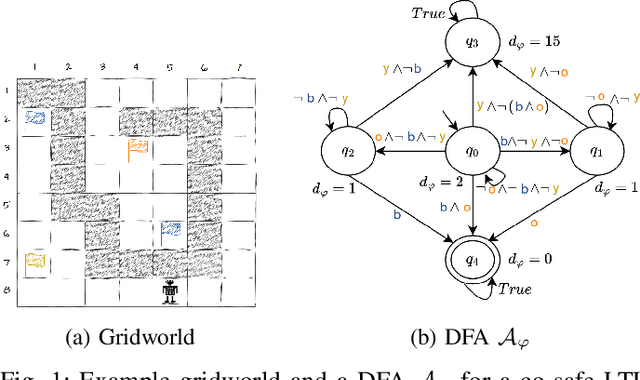
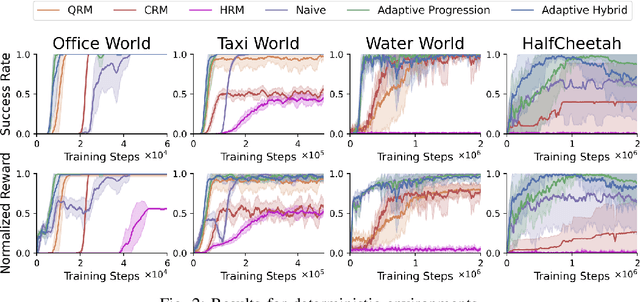
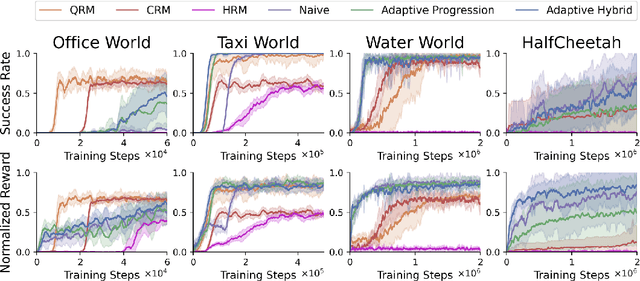

Abstract:There is a surge of interest in using formal languages such as Linear Temporal Logic (LTL) and finite automata to precisely and succinctly specify complex tasks and derive reward functions for reinforcement learning (RL) in robotic applications. However, existing methods often assign sparse rewards (e.g., giving a reward of 1 only if a task is completed and 0 otherwise), necessitating extensive exploration to converge to a high-quality policy. To address this limitation, we propose a suite of reward functions that incentivize an RL agent to make measurable progress on tasks specified by LTL formulas and develop an adaptive reward shaping approach that dynamically updates these reward functions during the learning process. Experimental results on a range of RL-based robotic tasks demonstrate that the proposed approach is compatible with various RL algorithms and consistently outperforms baselines, achieving earlier convergence to better policies with higher task success rates and returns.
From Model Explanation to Data Misinterpretation: Uncovering the Pitfalls of Post Hoc Explainers in Business Research
Aug 30, 2024



Abstract:Machine learning models have been increasingly used in business research. However, most state-of-the-art machine learning models, such as deep neural networks and XGBoost, are black boxes in nature. Therefore, post hoc explainers that provide explanations for machine learning models by, for example, estimating numerical importance of the input features, have been gaining wide usage. Despite the intended use of post hoc explainers being explaining machine learning models, we found a growing trend in business research where post hoc explanations are used to draw inferences about the data. In this work, we investigate the validity of such use. Specifically, we investigate with extensive experiments whether the explanations obtained by the two most popular post hoc explainers, SHAP and LIME, provide correct information about the true marginal effects of X on Y in the data, which we call data-alignment. We then identify what factors influence the alignment of explanations. Finally, we propose a set of mitigation strategies to improve the data-alignment of explanations and demonstrate their effectiveness with real-world data in an econometric context. In spite of this effort, we nevertheless conclude that it is often not appropriate to infer data insights from post hoc explanations. We articulate appropriate alternative uses, the most important of which is to facilitate the proposition and subsequent empirical investigation of hypotheses. The ultimate goal of this paper is to caution business researchers against translating post hoc explanations of machine learning models into potentially false insights and understanding of data.
ADESSE: Advice Explanations in Complex Repeated Decision-Making Environments
May 31, 2024Abstract:In the evolving landscape of human-centered AI, fostering a synergistic relationship between humans and AI agents in decision-making processes stands as a paramount challenge. This work considers a problem setup where an intelligent agent comprising a neural network-based prediction component and a deep reinforcement learning component provides advice to a human decision-maker in complex repeated decision-making environments. Whether the human decision-maker would follow the agent's advice depends on their beliefs and trust in the agent and on their understanding of the advice itself. To this end, we developed an approach named ADESSE to generate explanations about the adviser agent to improve human trust and decision-making. Computational experiments on a range of environments with varying model sizes demonstrate the applicability and scalability of ADESSE. Furthermore, an interactive game-based user study shows that participants were significantly more satisfied, achieved a higher reward in the game, and took less time to select an action when presented with explanations generated by ADESSE. These findings illuminate the critical role of tailored, human-centered explanations in AI-assisted decision-making.
Safe POMDP Online Planning among Dynamic Agents via Adaptive Conformal Prediction
Apr 23, 2024Abstract:Online planning for partially observable Markov decision processes (POMDPs) provides efficient techniques for robot decision-making under uncertainty. However, existing methods fall short of preventing safety violations in dynamic environments. This work presents a novel safe POMDP online planning approach that offers probabilistic safety guarantees amidst environments populated by multiple dynamic agents. Our approach utilizes data-driven trajectory prediction models of dynamic agents and applies Adaptive Conformal Prediction (ACP) for assessing the uncertainties in these predictions. Leveraging the obtained ACP-based trajectory predictions, our approach constructs safety shields on-the-fly to prevent unsafe actions within POMDP online planning. Through experimental evaluation in various dynamic environments using real-world pedestrian trajectory data, the proposed approach has been shown to effectively maintain probabilistic safety guarantees while accommodating up to hundreds of dynamic agents.
Trust-Aware Motion Planning for Human-Robot Collaboration under Distribution Temporal Logic Specifications
Oct 02, 2023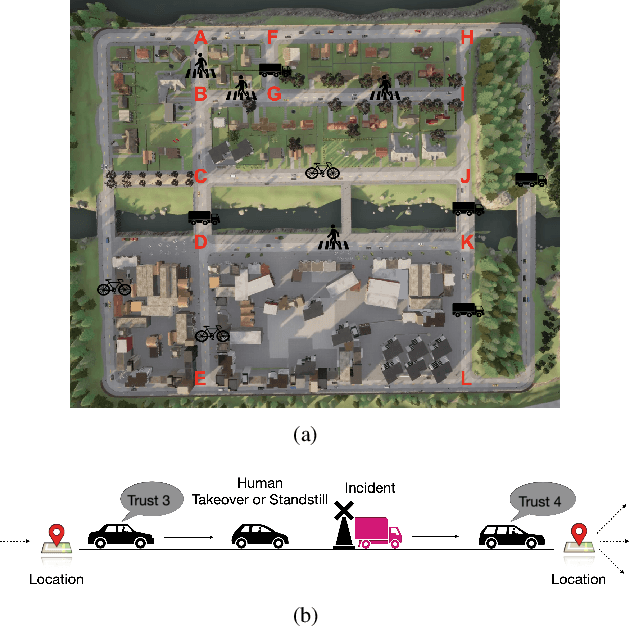
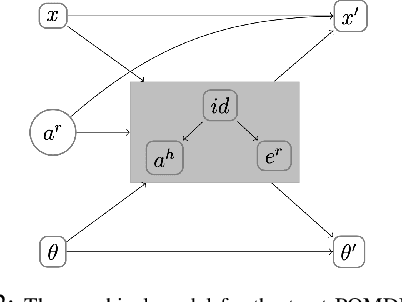
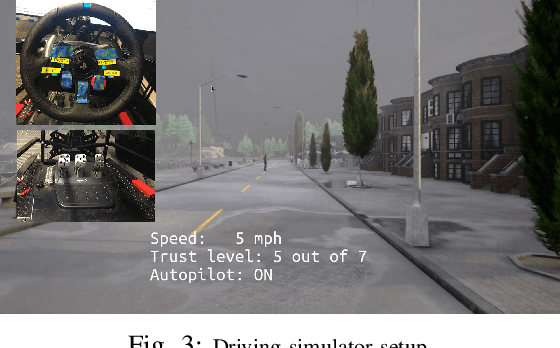
Abstract:Recent work has considered trust-aware decision making for human-robot collaboration (HRC) with a focus on model learning. In this paper, we are interested in enabling the HRC system to complete complex tasks specified using temporal logic that involve human trust. Since human trust in robots is not observable, we adopt the widely used partially observable Markov decision process (POMDP) framework for modelling the interactions between humans and robots. To specify the desired behaviour, we propose to use syntactically co-safe linear distribution temporal logic (scLDTL), a logic that is defined over predicates of states as well as belief states of partially observable systems. The incorporation of belief predicates in scLDTL enhances its expressiveness while simultaneously introducing added complexity. This also presents a new challenge as the belief predicates must be evaluated over the continuous (infinite) belief space. To address this challenge, we present an algorithm for solving the optimal policy synthesis problem. First, we enhance the belief MDP (derived by reformulating the POMDP) with a probabilistic labelling function. Then a product belief MDP is constructed between the probabilistically labelled belief MDP and the automaton translation of the scLDTL formula. Finally, we show that the optimal policy can be obtained by leveraging existing point-based value iteration algorithms with essential modifications. Human subject experiments with 21 participants on a driving simulator demonstrate the effectiveness of the proposed approach.
Safe POMDP Online Planning via Shielding
Sep 19, 2023Abstract:Partially observable Markov decision processes (POMDPs) have been widely used in many robotic applications for sequential decision-making under uncertainty. POMDP online planning algorithms such as Partially Observable Monte-Carlo Planning (POMCP) can solve very large POMDPs with the goal of maximizing the expected return. But the resulting policies cannot provide safety guarantees that are imperative for real-world safety-critical tasks (e.g., autonomous driving). In this work, we consider safety requirements represented as almost-sure reach-avoid specifications (i.e., the probability to reach a set of goal states is one and the probability to reach a set of unsafe states is zero). We compute shields that restrict unsafe actions violating almost-sure reach-avoid specifications. We then integrate these shields into the POMCP algorithm for safe POMDP online planning. We propose four distinct shielding methods, differing in how the shields are computed and integrated, including factored variants designed to improve scalability. Experimental results on a set of benchmark domains demonstrate that the proposed shielding methods successfully guarantee safety (unlike the baseline POMCP without shielding) on large POMDPs, with negligible impact on the runtime for online planning.
 Add to Chrome
Add to Chrome Add to Firefox
Add to Firefox Add to Edge
Add to Edge